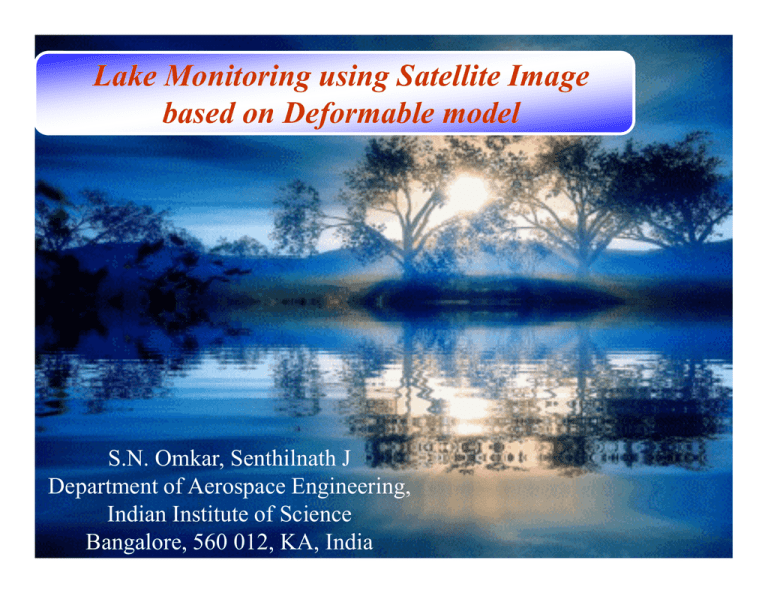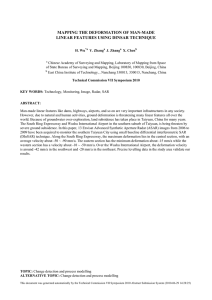Lake Monitoring using Satellite Image based on Deformable model
advertisement

Lake Monitoring using Satellite Image based on Deformable model S.N. Omkar, Senthilnath J Department of Aerospace Engineering Engineering, Indian Institute of Science Bangalore, 560 012, KA, India Presentation Layout y 9 9 9 9 9 Objective Motivation Loop holes of existing system Proposed system Conclusion Objective j • Design of a lake monitoring system using satellite images. • Extracted water covered region image can be used to - planning efficient water use - expanded or destroyed based on time series • IIntegrate t t Structural St t l andd spatial ti l Knowledge K l d - texture and spectral information • Design pixel-by-pixel with high accuracy image segmentation Motivation • Lake monitoring from remotely sensed images has always b been a challenging h ll i problem. bl • One of the main sources which can capture the temporal nature of the knowledge is the satellite image • Sensors that provide fine spatial resolution data for automated feature extraction. • Accurate knowledge on water covered region information is essential for - GIS databases, databases - Water usage planning, - emergency response applications. Motivation • Since mankind is able to take pictures from outer space, space it has always been a difficult task to recognize specific patterns, related to a special problem. • As computer science raised a stadium where computers are able to perform some ”intelligent” tasks, a wide research area established in solving the problem of lake monitoring system. • Satellite Image Classification and boundary extraction - assessment of different land cover types over a certain geographic hi region i andd to determine d i its i extent Loopp holes off Existing g System y •Various Various work has not yet proved in a completely satisfactory way the competitiveness of satellite based methods compared with ground measures and aerial surveys. •The water coverage assessment using satellite image to get subpixel accuracy. •Geospatial database embedding water covered region CASST’2007 Proposed system The proposed methodology has been broadly divided into four steps: • Image Classification • Nearest N t neighborhood i hb h d grouping i (NNG) • Deformation Method • Performance Evaluation Image g classification f •The image used is a high resolution satellite image of the urban Bangalore area in Karnataka, India. It has dimensions of 897 x 561 pixels. •By setting the threshold value 0.95, the high resolution image was grouped into 50 clusters in an unsupervised classification, five of which corresponds to water region. •A few cases of misclassification of water to roads and vegetations were also seen. Result – Image g Classification f VegetationVegetationTrees VegetationVegetationGrass Water Road Urban Shadow Bare Ground Nearest Neighborhood Grouping (NNG) •A nearest neighborhood i hb h d grouping i (NNG) ( ) operation i is i applied li d to the h classified image. •Smoothes h the h neighborhood. spectrall response within i hi the h pixel’s i l l l local •In I this thi process the th small ll patches t h off water t contrast t t abnormalities b liti are eliminated. Results - NNG Deformation Method •Deformation models are curves or surfaces of objects defined within an image domain that can move under the influence of internal forces and external forces. •The design of internal forces is to keep the model smooth during deformation whereas an external force is to move the model toward an object boundary. •Since Since deformable models are implemented on the continuum, the resulting boundary representation can achieve sub-pixel accuracy. •There are basically two types of deformable models: -Parametric P t i Deformable D f bl Model M d l (PDM) and d -Geometric Deformable Model (GDM). Snake and Level set algorithm are the type of formulation for PDM and •Snake GDM respectively. Parametric Deformation Method: Snake •The snake-based contour extraction is that the search for a contour is focused by specifying snake’s initial position as a parametric curve. •Contour is said to possess energy (Esnake) which is defined as the sum of the two energy terms. terms Esnakes(v) = Eint(v)+Eext(v) •Eint represents ep ese s thee internal e a energy e e gy too smooth s oo thee shape s ape of o curve, cu ve, 2 2 1 ∂v( s ,t ) ∂ 2 v( s ,t ) E int ( v ) = ∫ α ( s ) ds + β( s ) 2 2 ∂s ∂s •Eext represent external energy to match the image features such as strong edges 1 E ext ( v ) = ∫ P( v( s ,t ))ds 0 Results - Snake Extracted water regions using Snake Geometric Deformation Model: Level Set Evolution -Allows automatic topology changes, merging and breaking. -The level set method will continue to propagate towards the boundary based on inflating pressure force (inside the object) and deflating pressure force (outside the object). -For the water cover mapping problem, it is desirable for pressure force to be less than or greater than zero, surrounding the edges of the true water covered region. region Geometric Deformation Model: Level Set Evolution 22-phase phase segmentation 1 level set function + C >0 initial(LSM)= − C <0 inflateLSM ⎧⎪if c > 0; ⎫⎪ ⎨else if c < 0; deflateLSM ⎬ ⎪⎩else if c = 0 ; on the object boundary ⎪⎭ Level Set Evolution − Image g u0 : Ω → ℜ − evolve a curve C to detect objects in u0 − the curve has to stop on the boundaries of the objects ε ( φ ) = μP( φ ) + ε g ,λ ,ν (φ ) -Thee external e te a energy e e gy Eg,λ,ν drives ves the t e zero e o level eve set toward towa d the t e gλν d object boundaries, -The internal energy μP( φ ) penalizes the deviation of from a signed distance function during its evolution. Results – Level Set Method Extracted water regions using LSM-Deflate Results – Level Set Method Extracted water regions using LSM-Inflate Performance Evaluation From the ground truth, ulsoor lake is spread over 0.5001 sq km Sl No No. Deformation method Deformation algorithm Area of water coverage in Sq km 1 Parametric Snakes 0 4199 0.4199 Level set method using g deflate 0.3715 Level set method g inflate using 0.3495 2 Geometric Conclusions • In this paper we present lake monitoring using satellite image to detect the area of water covered region using parametric and geometric deformation method for high resolution imagery. p approach pp resulted in a • Classification based on the unsupervised satisfactory extraction of water region. • The Snake and level set method (inflate and deflate) helped to detect water cover mapping. mapping • We have shown that the model is robust and it is able to retrieve water coverage g region g in anyy image g samples. p • Initial results are indeed very promising and indicate robust modeling capability to retrieve automatically the water distributed area. area Thank You





